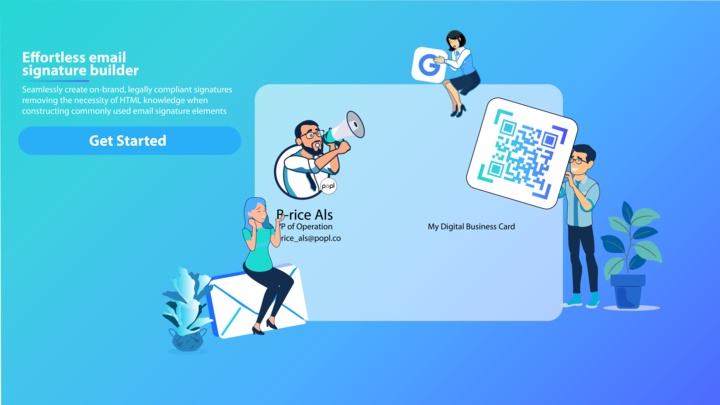In an increasingly digital world, the importance of a well-designed business card should not be underestimated.
While digital networking tools are convenient, a tangible, visually appealing business card can leave a lasting impression and effectively differentiate you from competitors. Integrating visuals into your business card design can enhance its impact, memorability, and professionalism.
This article explores successful examples and case studies of business cards that utilize visuals, analyzes the impact of visuals on brand perception and first impressions, and highlights the importance of visuals in standing out in a digital landscape.
The Importance of Business Cards in Professional Networking
Despite the rise of digital communication, business cards remain a crucial tool for networking and professional interactions. They offer a tangible representation of your brand and can be exchanged effortlessly in various settings, from conferences to casual meetups.
Business cards facilitate immediate connection and provide a physical reminder of the interaction, which can be essential in crowded networking environments where names and faces are easily forgotten.
In addition, business cards serve as a mini-resume, offering a snapshot of your professional identity. According to Small Business Trends, 72% of people judge a company or person based on the quality of their business card.
Thus, the design and quality of your business card can significantly influence the first impression you make on potential clients or partners.
With digital business card services, this first impression can be even more impactful, integrating modern design elements and interactive features that traditional cards lack.
The Role of Visuals in Creating a Memorable Business Card
Visuals play a pivotal role in making a business card memorable. A well-designed business card with high-quality visuals can capture attention and convey professionalism and creativity.
Here’s how visuals can elevate your business card:
High-Quality Multimedia
Including high-resolution images, professional headshots, and well-produced videos can enhance the appeal of your digital business card. These elements not only make your card visually attractive but also provide recipients with a glimpse of your personality and professionalism.
Business cards with pictures are 2.5 times more likely to be kept and remembered by recipients compared to text-only cards.
Interactive Elements
Interactive elements such as QR codes and embedded links can transform a simple business card into a dynamic tool for engagement.
By incorporating QR codes, recipients can easily access your digital portfolio, website, or LinkedIn profile with a simple scan. This not only makes it convenient for them to learn more about you but also ensures that they have access to your most up-to-date information.
Popl’s digital business card services offer real-time updates, so your contact information, job title, or company details are always accurate.
Showcasing Achievements and Testimonials
Your digital business card can also showcase your achievements, certifications, and client testimonials, building credibility and trust. By highlighting your accomplishments, you establish your expertise and authority in your field.
Testimonials from satisfied clients can further reinforce your value, making you a more attractive prospect to potential clients or partners.
According to a report by BrightLocal, 88% of people trust online reviews as much as personal recommendations, making testimonials a powerful tool for building trust.
Consistent Branding
A cohesive brand identity can be achieved through consistent use of colors, logos, and fonts. Your business card should reflect your unique brand and personality, making it instantly recognizable.
For instance, financial professionals can benefit from a consistent color scheme and professional imagery to convey trust and reliability. Personal branding in the finance industry is crucial, as it helps build trust and establishes you as a thought leader in your field.
Multimedia Portfolios
For creative professionals, digital business cards can link to online portfolios or multimedia showcases. Rather than sharing a single example of your work, you can provide a comprehensive view of your capabilities.
Performance and musical artists, for example, can share videos of studio work or live performances, while writers can link to a collection of their published articles or a page of clippings.

How Adding a Picture to Your Business Card Enhances Your Professional Image
Including a picture on your business card can significantly enhance your professional image in several ways. Here are some key benefits:
Personal Connection
A picture can establish a personal connection between you and the recipient. When potential clients or partners see your face, they are more likely to remember you. This visual cue helps bridge the gap between a fleeting encounter and a lasting professional relationship.
According to a study by the Association for Psychological Science, people are more likely to remember faces than names or job titles. By adding your photo, you make it easier for people to recall who you are and the context in which they met you.
Building Trust
A professional headshot can convey trustworthiness and approachability. In industries where trust is paramount, such as finance or healthcare, showing your face can make a significant difference.
A well-crafted digital business card with a professional image signals that you are transparent and confident, essential traits for building credibility.
Brand Consistency
For businesses, incorporating a brand-related image, such as a logo or a product photo, ensures consistency across all marketing materials. This not only reinforces brand identity but also helps in making your card instantly recognizable.
Consistent use of brand visuals helps in building a cohesive brand image, making your business appear more reliable and professional.
Showcasing Expertise
Images can also be used to highlight your expertise. For instance, if you are a photographer, including a thumbnail of your best work can serve as a mini-portfolio.
Similarly, designers, artists, and other creative professionals can showcase a piece of their work directly on their business card. This immediate demonstration of your skills can be a powerful tool in persuading potential clients to engage with your services.
Enhancing Memorability
A visually appealing business card is more likely to be kept and remembered. Digital business card services allow for the integration of multimedia elements, such as short introductory videos or animated logos, making your card not only memorable but also interactive.
Choosing the Right Picture for Your Business Card
Selecting the right image for your business card is crucial for maximizing its impact. Here are some tips to help you choose the most appropriate and impactful images:
Professional Headshot
For individual professionals, a high-quality, professional headshot is a must. Ensure the photo is well-lit, high-resolution, and up-to-date.
Dress appropriately for your industry and maintain a friendly yet professional demeanor. This headshot should ideally match the one used on your LinkedIn profile to ensure consistency across platforms.
Brand Logo
For businesses, the brand logo should be prominently displayed. A clean, high-resolution logo ensures that your brand is easily recognizable. Avoid cluttering the card with multiple logos or images; simplicity and clarity are key to making a strong visual impact.
Relevant Imagery
Choose images that are relevant to your industry or the services you offer. For instance, a real estate agent might include a photo of a beautiful home they sold, while a chef might feature a high-quality image of a signature dish. They can also remove the background to make the main image elements stand out more and create a professional, polished look.
High quality visuals provide immediate context about your expertise and services, making it easier for recipients to understand what you offer.
Consistent Branding
Maintain consistency in colors, fonts, and overall design to ensure that the image aligns with your brand identity. This cohesive approach reinforces your brand message and makes your business card look more polished and professional.
Avoid Overcrowding
While visuals are important, it's essential not to overcrowd your business card with too many images. Focus on one or two high-quality visuals that convey your message effectively.
Overloading the card with images can make it look cluttered and unprofessional.
Use of Tools
Utilize tools like Canva to adjust and enhance your images. Make sure your photos fit well within the card's layout, and consider adding subtle effects, like a gradient background, to make them stand out.
A clean, well-designed card is more likely to leave a positive impression.
Design Tips for Incorporating Visuals on Your Business Card
Integrating visuals into your business card design can significantly enhance its impact, but it's essential to do so thoughtfully to avoid overwhelming the card.
Here are some design tips to help you effectively incorporate visuals:
Balance and White Space
Balance is key to a well-designed business card. Ensure that your visuals do not dominate the card but rather complement the text. Use ample white space to give the design room to breathe and avoid a cluttered appearance.
A minimalist design can create a modern and professional look while ensuring that the essential information is easy to read.
Strategic Placement
Place visuals strategically to draw attention to key information. For instance, a professional headshot can be placed in the top corner, while your logo might be centered at the bottom.
This placement helps guide the recipient's eye across the card in a logical flow, making it easier for them to absorb the information.
High-Quality Images
Always use high-resolution images to ensure clarity and sharpness. Blurry or pixelated images can detract from the professionalism of your card. Invest in professional photography or use high-quality stock images that align with your brand’s aesthetic.
Consistent Branding
Ensure that your visuals align with your brand’s identity. Use consistent colors, fonts, and styles that match your other marketing materials. This consistency reinforces your brand and makes your business card instantly recognizable.
For instance, if your brand colors are blue and white, use these colors in the card’s design elements and visuals.
Avoid Overloading
Limit the number of visuals to avoid clutter. Focus on one or two key images that represent your brand or professional identity.
For example, use your logo and a headshot, or a logo and a relevant industry image. Too many visuals can overwhelm the recipient and dilute the card’s message.
Clear and Readable Text
Ensure that the text remains clear and readable despite the presence of visuals. Use contrasting colors to make the text stand out against the background images. Avoid placing text over busy images, which can make it difficult to read.
Interactive Elements
Consider adding interactive elements like QR codes. These can be subtly integrated into the design without overwhelming the card.
QR codes can link to your digital portfolio, website, or contact information, providing additional value without taking up too much space.
Printing Options for Business Cards with Visuals
High-quality visual reproduction on business cards depends not only on the design but also on the printing techniques and materials used. Here are some printing options to consider:
Digital Printing
Digital printing is a cost-effective option, especially for small print runs. It offers high-quality color reproduction and allows for quick turnaround times. This method is ideal for those who need a small batch of business cards or frequent updates to their design.
Offset Printing
Offset printing is a traditional method that offers superior color accuracy and consistency. It’s ideal for larger print runs and produces high-quality results, making it a preferred choice for business cards with intricate designs and vibrant colors.
Although it may be more expensive than digital printing, the quality and durability of the cards often justify the cost.
UV Coating
UV coating adds a glossy finish to your business cards, enhancing the vibrancy of the colors and protecting the card from wear and tear. This option is particularly effective for cards with photos or detailed visuals, as it makes the images pop and gives the card a premium feel.
Matte Finish
For a more understated and professional look, consider a matte finish. Matte cards are less reflective than glossy ones, which can make them easier to read in bright lighting. This finish is ideal for designs that rely on subtle color schemes and clean lines.
Spot UV
Spot UV is a technique where a UV coating is applied only to specific areas of the card, such as a logo or a particular image. This creates a contrast between the glossy and matte areas, making certain elements stand out.
Spot UV can add a touch of sophistication and focus attention on key visuals.
Embossing and Debossing
Embossing (raising) or debossing (recessing) specific elements of your card can add a tactile dimension to your design.
These techniques are perfect for highlighting your logo or name, giving the card a unique and memorable texture. They work well with minimalist designs, adding a layer of sophistication without overwhelming the card.
Foil Stamping
Foil stamping involves applying a metallic foil to certain parts of the card, such as logos or text, to create a shiny, eye-catching effect. Gold, silver, and other metallic colors can add a touch of luxury and professionalism to your business card, making it stand out in a stack.
High-Quality Card Stock
The quality of the card stock can significantly impact the overall look and feel of your business card. Opt for thick, durable card stock to convey a sense of quality and professionalism.
Premium card stock not only looks better but also feels more substantial, making a stronger impression on recipients.

Examples of Successful Business Cards with Visuals
Apple Inc.
Apple Inc. is renowned for its sleek, minimalist business cards that perfectly embody the brand's ethos of simplicity and innovation. These cards feature clean lines, a subtle logo, and a professional layout, making them instantly recognizable and memorable.
The minimalist design reflects Apple's commitment to quality and innovation, aligning the business card with the overall brand image.
LinkedIn’s business cards incorporate a QR code that links directly to the individual's LinkedIn profile. This blend of traditional networking with digital convenience saves space on the card while enhancing interactivity and engagement.
It allows recipients to instantly connect and view the professional's full profile, making the card not just a piece of paper but a gateway to further professional interaction.
Financial Advisors
In the financial sector, professionals often use digital business cards to present a polished and modern image. These cards may include professional headshots, company logos, and links to their professional profiles and testimonials.
Such elements help in building trust and credibility, essential traits in the finance industry. The cards often feature a clean design with subtle use of colors to emphasize professionalism.
The Impact of Visuals on the Perception of Your Brand (Professional Image and First Impressions)
Enhanced Memorability
Visuals significantly enhance the memorability of your business card. Studies have shown that people are more likely to remember visual information over text.
A well-chosen image or logo can stick in the recipient’s mind long after the initial meeting, ensuring that your brand remains top of mind.
Building Trust and Credibility
Visuals such as professional headshots or brand logos help build trust and credibility. A high-quality headshot conveys professionalism and approachability, while a well-designed logo reinforces brand identity.
These elements signal to the recipient that you are a serious and credible professional, increasing the likelihood of future engagement.
Reflecting Brand Identity
Visuals can effectively reflect your brand identity. Colors, logos, and design elements should be consistent with your overall branding strategy.
For instance, using your brand’s color scheme on the business card helps reinforce brand recognition and consistency across all marketing materials.
Creating a Positive First Impression
The first impression is crucial in any professional interaction. A visually appealing business card can create a positive first impression, signaling that you are detail-oriented and professional.
According to research published in the Journal of Business Research, first impressions formed in the first few seconds of interaction can significantly influence the long-term perception of your brand.
Using Visuals to Make Your Business Card Stand Out in a Digital World
Differentiation
In an increasingly digital world, physical business cards that effectively use visuals can stand out. While digital cards are convenient, a tangible, well-designed business card can leave a lasting impression.
The tactile experience of a high-quality card combined with striking visuals can differentiate you from competitors who might rely solely on digital interactions.
Integration with Digital Platforms
Visuals on business cards can also serve as gateways to digital platforms. QR codes and NFC-enabled cards can link to your online profiles, portfolios, or websites.
This integration bridges the gap between physical and digital networking, offering a seamless way for recipients to connect with you online.
Interactive Elements
Adding interactive elements such as QR codes, augmented reality features, or embedded videos can make your business card more engaging.
These elements provide additional value to the recipient, making the card not just a source of contact information but an interactive tool that can provide further insights into your brand and services.
Enhancing Professional Image
A business card with high-quality visuals can significantly enhance your professional image. It shows that you are up-to-date with modern design trends and technologies, positioning you as a forward-thinking professional.
This is particularly important in industries where innovation and cutting-edge approaches are valued.
Conclusion
Integrating visuals into your business card design offers numerous benefits, from enhancing memorability and building trust to differentiating your brand in a crowded marketplace.
Successful examples from companies like Apple and LinkedIn demonstrate the power of effective visual design.
By carefully selecting and incorporating the right visuals, you can create a business card that not only stands out but also leaves a lasting, positive impression on recipients. In an increasingly digital world, a well-designed business card with impactful visuals can be a powerful tool for networking and professional growth.















